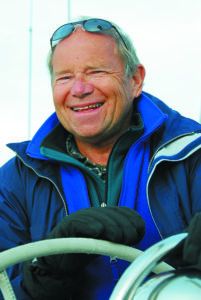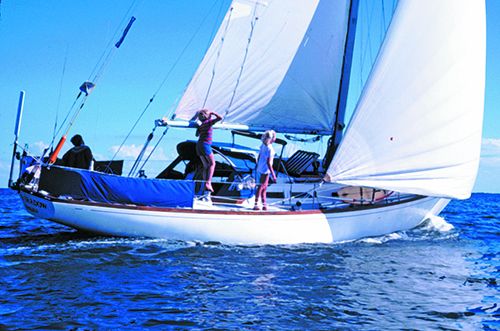When I started cruising aboard a 26 foot, tiller steered sloop. I learned the value of simplicity. Fewer components meant that there was less to fail and fewer things to fix. Despite all the upsides of doing more with less, I dreamed about a wheel-steered 40 footer and days spent surfing down trade wind seas.
Some years later, my wife and I were headed westward on a family voyage around the world. The 26-foot pocket cruiser had been replaced with a wheel steered, 41-foot sloop that we named Wind Shadow. In those days, wheel steering was an add-on option and most boats in the 40 foot range still retained the ability to easily switch from a wheel to a tiller. Fortunately, the tiller had yet to become a vestigial organ.
We learned an important lesson about wheel steering a few days and a few hundred miles northwest of Cape Town, SA. Wind Shadow was reaching in 20 knots true under a reefed main, high cut jib and staysail. One moment, all was well and the next the helm spun like a roulette wheel. We gained some directional control by easing and trimming the sheets. It was enough to prevent the boat from rounding up or jibing, but it was clear that sheet steering in a good sized seaway was marginally effective at best.
What saved the day was the ease with which we could transition to tiller steering. In just a few minutes, a four foot, ash tiller was attached to the bronze fitting at top of the rudder stock and things were back under control. Ironically, the pendulum servo self-steering vane favored the tiller, steering the boat more efficiently thanks to the lack of the helm’s “flywheel effect”.
The steering failure had been caused by a broken idler pulley bracket, an essential part of the steering system that guides the wire cable on its run from the helm to the quadrant. In this case, a stainless steel axle pin, on which the bronze sheave rotated, had corroded enough to bind itself to the sheave. This caused the pin to rotate in the bracket, wearing the fitting away. More frequent cleaning and lubrication might have prevented the problem and is a good reason why a pre-passage steering system inspection should include a careful look at all of the moving parts.

Thanks to the efficiency of easy access to tiller steering aboard many older wheel steered boats, there was no need for an at sea repair. The full-length tiller fit the proportions of the cockpit and was quickly connected to the head of the rudder stock. The net result was a fully effective back up means of steering—just the opposite of the makeshift, high friction, contrivances we find on all too many sailboats today. On that Atlantic crossing, we sailed over 3,000 miles with the tiller in place. Very few “in the good old days” recollections hold as much validity.
Renowned safety at sea expert and Practical Sailor contributing writer Ralph Naranjo is the author of The Art of Seamanship and the cruising narrative Wind Shadow West.
Related posts: “Steady at the Helm“; “Emergency Steering is Getting a Short Shrift“









































I ordered a new subscription to Practical Sailor on March 1st and would like to know about how long it takes to receive my first printed monthly edition. Thank you.
Mr. Naranjo: I began sailing in 1970. In those days before GPS, when one took a sextant shot and wanted to plot it, there were many books that reduced the shot and did the math. Now i have a radio with AIS. Does the computer automatically do the required math in order to reduce the sextant shot. Can I plot the info that comes out of the radio?
I will appreciate your information.
Gerald Pollack
soon too be 90 years old.